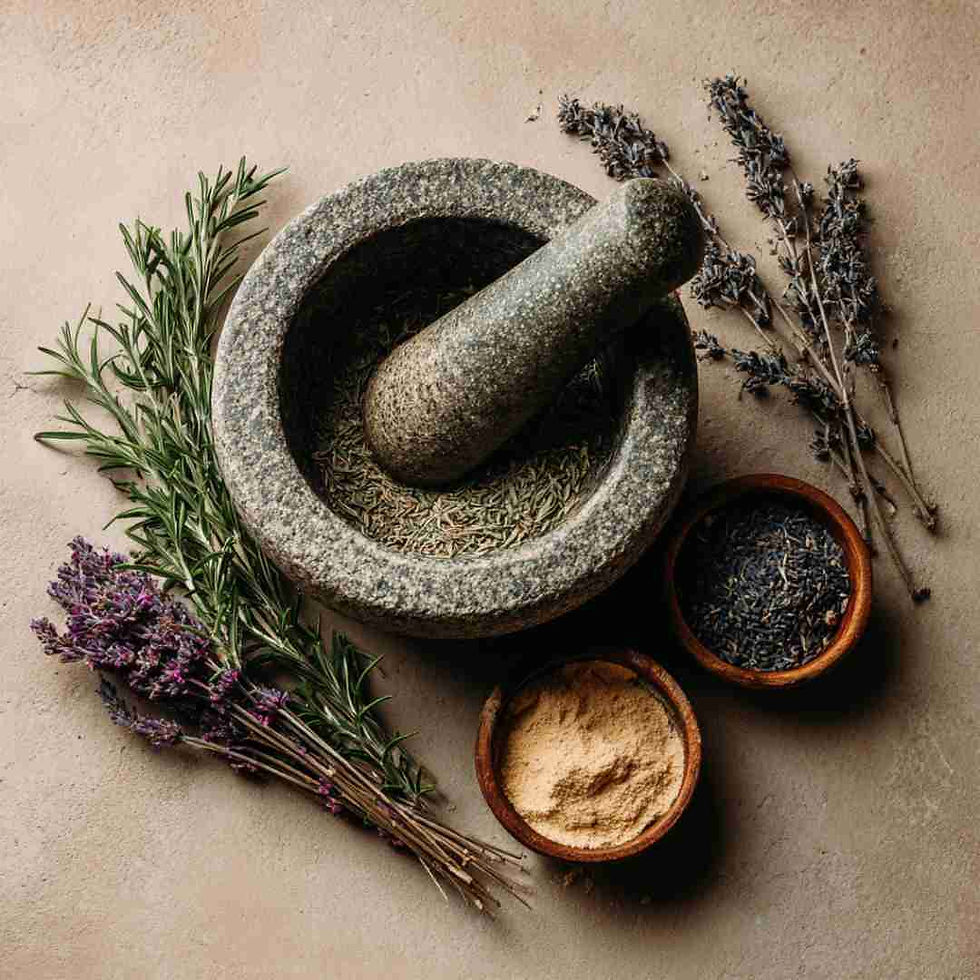The Ultimate Guide to Incense: Sticks, Cones & Seasonal Rituals
- Astrid van Essen
- Sep 18
- 4 min read
Updated: Oct 31
Embracing slow living has taught me to find joy in the smallest rituals. Making incense from scratch calms my mind—it’s almost meditative. There’s something grounding about rolling herbs into cones or lighting a stick at the end of the day, letting the smoke curl slowly through the air. In this, The Ultimate Guide to Incense, I’ll share everything I’ve learned about incense: from its history and benefits to seasonal blends and simple DIY recipes you can try at home.

What Is Incense?
Incense has been used for centuries across cultures. In temples, homes, and sacred ceremonies, the fragrant smoke was believed to connect the earthly and the divine. From sandalwood in India to frankincense in the Middle East, each tradition gave incense its own unique role.
Today, incense is no longer confined to ritual—it’s found in meditation practices, home fragrance, yoga studios, and even simple moments of relaxation. For me, it bridges both worlds: a nod to ancient traditions and a comforting part of my modern slow living practice.
Types of Incense
Incense Sticks
The most familiar form, incense sticks, is made by binding powdered herbs and resins onto a bamboo core. They burn steadily, releasing fragrance for around 30–60 minutes. Popular choices include sandalwood, lavender, patchouli, and rose.
Incense Cones
Cones are compact and release more concentrated smoke in a shorter time. I like them when I want to quickly create an atmosphere in a small room, especially during colder months.
Resin & Loose Incense
Before sticks and cones, incense was simply a raw material—resins like frankincense, myrrh, or copal placed on glowing charcoal. This form feels more traditional, producing a rich, smoky scent that lingers.
Benefits of Burning Incense
Relaxation and stress relief – the act of lighting incense is often as calming as the scent itself.
Meditation and mindfulness – incense provides a sensory anchor that helps me stay present.
Cleansing energy – herbs like sage and rosemary have long been used to purify spaces.
Seasonal atmosphere – a spiced cone in autumn or a pine-scented stick at Christmas instantly shifts the mood.
Seasonal Incense Rituals
Autumn Incense
As the days grow shorter, I lean towards warm, spiced woods. Cinnamon, clove, and cedar create a cosy, grounding blend. Read more: Best Incense Scents for Autumn: From Spiced Woods to Pumpkin-Inspired Blends.
Winter & Christmas Incense
Nothing feels more festive than frankincense, pine, and cinnamon. These scents fill a room with warmth and nostalgia. Read more: DIY Festive Incense Sticks with Pine, Frankincense & Cinnamon.
Spring Incense
Spring is all about renewal. Sage, rosemary, and lavender are cleansing herbs that clear away stale energy.
Coming soon: Cleansing Incense for Spring Renewal.
Summer Incense
In summer, I reach for cooling, fresh scents. Mint, lemongrass, and citronella not only smell refreshing but also help keep insects at bay. Coming soon: Best Incense for Relaxing Summer Evenings.
How to Use Incense Safely
Place sticks or cones in a proper holder or on a ceramic dish.
Always burn in a well-ventilated space.
Keep away from children, pets, and anything flammable.
Allow ash to cool before disposal.
DIY Incense Recipes
How to Make Incense Sticks at Home
All you need is powdered herbs, makko powder (a natural binder), and a small amount of water. Blend your ingredients, roll them onto bamboo sticks, and let them dry. It’s simple, calming, and endlessly customisable.
DIY Incense Cones
To make cones, combine powdered herbs and makko powder, add water, and shape into small cones. I love creating autumn blends with cinnamon, clove, and orange peel. For winter, pine needles and frankincense are perfect.
Find my detailed seasonal recipes in:
DIY Festive Incense Sticks
DIY Floral Incense Cones (Spring)
Natural vs Synthetic Incense
Not all incense is created equal. Some commercially made sticks contain synthetic fragrances and fillers that can feel harsh on the skin. I always choose natural incense made with herbs, woods, and resins—or, even better, I make my own. It ensures a cleaner burn and a more authentic experience.
Where to Buy or How to Make Your Own
If making incense feels daunting, there are sustainable brands that use natural ingredients. But I encourage you to try at least one homemade batch. For me, the process itself is therapeutic: measuring herbs, shaping cones, and waiting for them to dry becomes a ritual as meaningful as burning them.
Read more about making your herbal incense blends here
The Ultimate Guide to Incense: Conclusion
Incense has carried meaning for centuries. For me, it’s about more than fragrance—it’s about slowing down, connecting with nature, and bringing mindful rituals into everyday life. Whether you burn a stick after work, make your own cones, or explore seasonal blends, incense is a simple way to create balance at home.
FAQs
1: What is the difference between incense sticks and cones?
Sticks burn longer with a steady release of fragrance, while cones burn faster with more concentrated smoke.
2: Can incense be made at home?
Yes. With basic ingredients like herbs, makko powder, and water, you can easily craft sticks or cones.
3: What herbs are best for seasonal incense?
Autumn: cinnamon, clove, cedar. Winter: pine, frankincense, myrrh. Spring: sage, lavender, rosemary. Summer: mint, lemongrass, citronella.
4: Is incense safe to burn indoors?
Yes, if used responsibly. Always burn in a holder, keep the space ventilated, and never leave incense unattended.
5: How long does incense typically burn?
Sticks usually burn for 30–60 minutes, cones for 15–30 minutes, depending on size and ingredients.



Comments